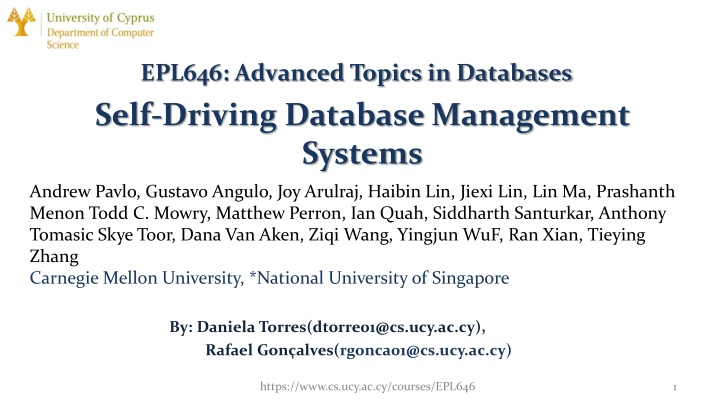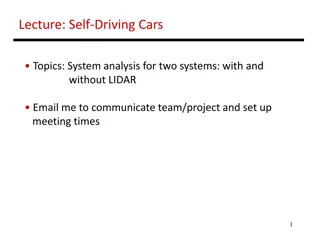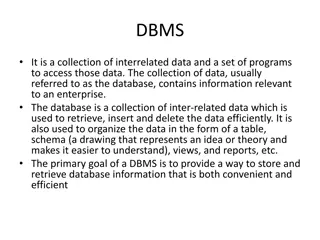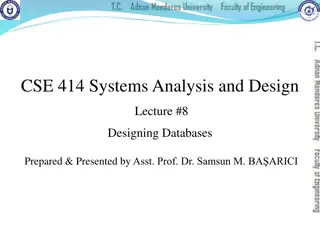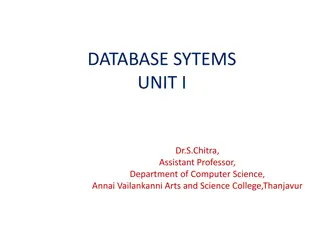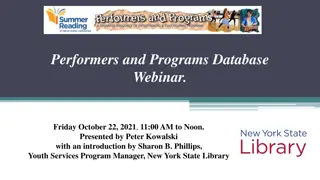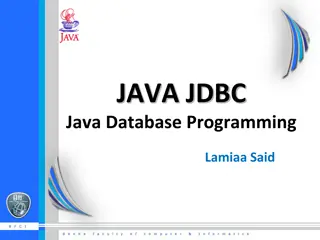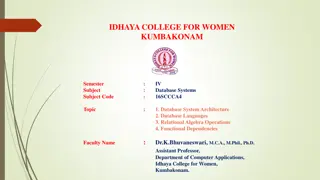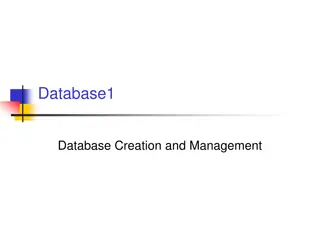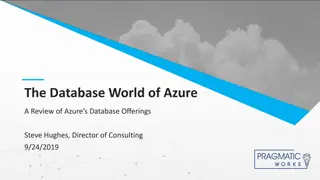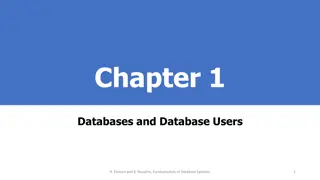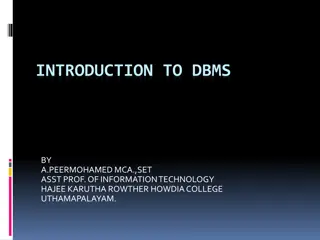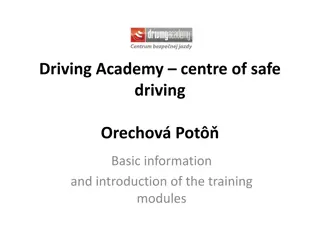Self-Driving Database Management Systems Overview
In recent years, advancements in self-driving database management systems have revolutionized the way databases are optimized and managed. This technology eliminates the need for human intervention in decision-making processes related to database tuning and performance optimization. Explore the architecture of Peloton, the pioneering self-driving DBMS, and learn about its integrated planning component that autonomously optimizes system operations based on current and predicted workload trends.
Download Presentation

Please find below an Image/Link to download the presentation.
The content on the website is provided AS IS for your information and personal use only. It may not be sold, licensed, or shared on other websites without obtaining consent from the author.If you encounter any issues during the download, it is possible that the publisher has removed the file from their server.
You are allowed to download the files provided on this website for personal or commercial use, subject to the condition that they are used lawfully. All files are the property of their respective owners.
The content on the website is provided AS IS for your information and personal use only. It may not be sold, licensed, or shared on other websites without obtaining consent from the author.
E N D
Presentation Transcript
EPL646: Advanced Topics in Databases Self-Driving Database Management Systems Andrew Pavlo, Gustavo Angulo, Joy Arulraj, Haibin Lin, Jiexi Lin, Lin Ma, Prashanth Menon Todd C. Mowry, Matthew Perron, Ian Quah, Siddharth Santurkar, Anthony Tomasic Skye Toor, Dana Van Aken, Ziqi Wang, Yingjun WuF, Ran Xian, Tieying Zhang Carnegie Mellon University, *National University of Singapore By: Daniela Torres(dtorre01@cs.ucy.ac.cy), Rafael Gon alves(rgonca01@cs.ucy.ac.cy) 1 https://www.cs.ucy.ac.cy/courses/EPL646
Presentation Outline (Indicative) Background Integration Problem overview Self-driving architecture Workload Classification Workload Forecasting Action Planning & Execution Preliminary Results Conclusions Student Research Presentations, Advanced Topics in Databases, Dept. of Computer Science University of Cyprus https://www.cs.ucy.ac.cy/courses/EPL646 2
Background In the last decades, advisory tools to assist DBAs in system tunning and physical design have been built but this work is incomplete because humans are still needed to make the final decisions about changes to the database For a self-driving DBMS we need a new architecture designed for autonomous operation This way, all aspects of the system are controlled by an integrated planning component which optimizes the system for the current workload and predicts future workload trends With this, DBMS doesn't require a human to determine the right way and proper time to deploy all of the previous tunning techniques We're presenting the architecture of Peloton, the first self-driving DBMS Student Research Presentations, Advanced Topics in Databases, Dept. of Computer Science University of Cyprus https://www.cs.ucy.ac.cy/courses/EPL646 3
Introduction Using a DBMS to remove the burden of data management allows that a developer only writes a query that specifies what data they want to access and the DBMS finds the most efficient way to store and retrieve data, and to safely interleave operations Using existing automated tunning tools is an onerous is a harsh task, as they require laborious preparation of workload samples, spare hardware to test proposed updates and above all else intuition into the DBMS's internals If DBMS's could do these things automatically, it would be less complicated and cheaper to deploy a database Most of the previous work on self-tunning systems is focused on standalone tools that target only a single aspect of the database Most of the tools of operate in the same way: the DBA provides it with a sample database and workload trace that guides a search process to find an optimal or near-optimal configuration Student Research Presentations, Advanced Topics in Databases, Dept. of Computer Science University of Cyprus https://www.cs.ucy.ac.cy/courses/EPL646 4
Introduction Introduction All of these are insufficient for a completely autonomous database because they are external to the DBMS, reactionary or unable to take a holistic view that considers more than one problem at a time Even if these tools were automated such that they could deploy the optimizations on their own, existing DBMS architecture are not designed to support major changes without stressing the system further nor are able to adapt in anticipation of future obstacles The architecture of Peloton is the first DBMS designed for autonomous operation Peloton Self-Driving Architecture Student Research Presentations, Advanced Topics in Databases, Dept. of Computer Science University of Cyprus https://www.cs.ucy.ac.cy/courses/EPL646 5
Problem Overview Problem Overview The first challenge in a self-driving DBMS is to understand an application's workload The most basic level is to characterize queries as being for either an OLTP or OLAP application One way to handle this is to deploy separate DBMSs that are specialized for OLTP and OLAP workloads and then periodically stream updates between them But there is an emerging class of applications, known as hybrid processing (HTAP), that cannot split the database across two systems because they execute OLAP queries on data as soon as it is written by OLTP transaction transaction-analytical Student Research Presentations, Advanced Topics in Databases, Dept. of Computer Science University of Cyprus https://www.cs.ucy.ac.cy/courses/EPL646 6
Problem Overview Problem Overview A better approach is to deploy a single DBMS that supports mixed HTAP workloads such a system automatically chooses the proper OLTP or OLAP optimizations for different database segments There are some workload anomalies that a DBMSs can never antecipate but these models provide an early warning that enables the DBMS to enact mitigation action more quickly than what monitoring system could support If the DBMS isn't able to apply these optimizations efficiently without incurring large performance degradations, the system won't be able to adapt to changes quickly an external Self-Driving Actions Student Research Presentations, Advanced Topics in Databases, Dept. of Computer Science University of Cyprus https://www.cs.ucy.ac.cy/courses/EPL646 7
Problem Overview Problem Overview A self-driving DBMS cannot support DBA tasks that require information that is external to the system, such as permissions, data cleaning and version control There are three optimization categories that a self-driving DBMS can support: for the database's physical design, changes to data organization and the last three affect the DBMS's runtime behavior An autonomous DBMS has two constraints it has to satisfy to be relevant for today's applications: it cannot require developers to rewrite their application to use a proprietary API or provide suplemental information about its behavior and it can't rely on program analysis tools that only support certain programming environements Student Research Presentations, Advanced Topics in Databases, Dept. of Computer Science University of Cyprus https://www.cs.ucy.ac.cy/courses/EPL646 8
Problem Overview Self-driving architecture Existing DBMSs are too unwidely for autonomous operation because they often require restarting when changes are made Peloton uses a variant of multi-version concurrency control that interleaves OLTP transactions and actions without blocking OLAP queries It uses as in-memory storage manager with lock-free data structures and flexible layouts that allows for fast execution of HTAP workloads Main goal is for Peloton to efficiently operate without any human-provided guide information The system automatically learns how to improve the latency of the application's queries and transactions latency is the most important metric in a DBMS as it captures all aspects of performance Peloton contains an embedded monitor that follows the system's internal event stream of the executed queries The DBMS then constructs forecast models for the application's expected workload from this monitoring data Student Research Presentations, Advanced Topics in Databases, Dept. of Computer Science University of Cyprus https://www.cs.ucy.ac.cy/courses/EPL646 9
Problem Overview Workload Classification Clustering the workload reduces the number of forecast models that the DBMS maintains Pelotons' initial implementation uses the DBSCAN algorithm which has been used to cluster static OLTP workloads One of the questions with this clustering is what query features to use Two types of query features: query's runtime metrics and query's logical systems Second problem is how to determine when the clusters are no longer correct. When this occurs, the DBMS has to re-build its clusters, which could shuffle the groups and require it to re-train all of its forecast models Peloton uses standard cross validation techniques to determine when the clusters' error rate goes above a thresold Student Research Presentations, Advanced Topics in Databases, Dept. of Computer Science University of Cyprus https://www.cs.ucy.ac.cy/courses/EPL646 10
Problem Overview Workload Forecasting We need to train forecast models that predict the arrival rate of queries for each workload cluster With the exception of anomalous hotspots, this forecasting enables the system to identify periodicity and data growth tends to prepare for load fluctuations The DBMS executes a query, then tags each one with its cluster identifier and then populates a histogram that tracks the number of queries that arrive per cluster within a time period Peloton uses this data to train the forecast models that estimate the number of queries per cluster that the app will execute in the future Previous attempts at autonomous systems have used the auto-regressing-moving average model (ARMA) to predict the workload of web services for autoscaling in the cloud Recurrent neutral networks (RNNs) are an effective method to predict time-series patterns for non-line systems A variant of RNNs called long short-term memory (LSTM) allow the networks to learn the periodicity and repeating trends in a time-series data beyond what's possible with regular RNNs Student Research Presentations, Advanced Topics in Databases, Dept. of Computer Science University of Cyprus https://www.cs.ucy.ac.cy/courses/EPL646 11
Problem Overview Workload Forecasting Peloton maintains multiple RNNs per group that's forecast the workload at different time horizons and internal granularities Combining multiple RNNs allows the DBMS to handle immediate problems where accuracy is more important as well as to accommodate longer term planning where the estimates can be broad Student Research Presentations, Advanced Topics in Databases, Dept. of Computer Science University of Cyprus https://www.cs.ucy.ac.cy/courses/EPL646 12
Action Planning & Execution This part is where the control framework is done: Monitors the system Selects the optimized actions Improve the application s performance. Action Generation: The system searches for actions that improves performance Stores those actions in catalog. Logs the systems updates. Guided by forecasting models. Regulates the use of CPUs. Certain actions have reversal actions. Student Research Presentations, Advanced Topics in Databases, Dept. of Computer Science University of Cyprus https://www.cs.ucy.ac.cy/courses/EPL646 13
Action Planning & Execution Action Planning: Decides the action based in: Forecasts; Current database configuration; Latency. Uses RHCM (Receding Horizon Control Model) Student Research Presentations, Advanced Topics in Databases, Dept. of Computer Science University of Cyprus https://www.cs.ucy.ac.cy/courses/EPL646 14
RHCM (Receding Horizon Control Model) What is it? Used to manage complex systems. Estimates the workload using the forecasts and search for the best actions that minimizes the latency of the function. It only deploys the first action and then wait till its finished. How it works? Tree Model where each level contains the actions that can be invoked. Estimates the cost-benefit of the actions and chooses the one with best outcome. The actions are selected randomly. Avoids the actions that were recently called and reversed by the system. Student Research Presentations, Advanced Topics in Databases, Dept. of Computer Science University of Cyprus https://www.cs.ucy.ac.cy/courses/EPL646 15
RHCM (Receding Horizon Control Model) Is it reliable? With short horizons the DBMS cant prepare itself to the upcoming load spikes With long horizons it can not solve sudden problems because the models are to big. So There are things that are not completely studied and are under investigation yet. Student Research Presentations, Advanced Topics in Databases, Dept. of Computer Science University of Cyprus https://www.cs.ucy.ac.cy/courses/EPL646 16
Action Planning & Execution Deployment: Actions are deployed in a non blocking way. Some actions need a special consideration. Deals with resource scheduling and contention issues from its integrated machine learning components. Uses GPU to handle heavy computation to avoid slowing down the DBMS. Student Research Presentations, Advanced Topics in Databases, Dept. of Computer Science University of Cyprus https://www.cs.ucy.ac.cy/courses/EPL646 17
Preliminary Results Specifications: Google TensorFlow integrated in Peloton; One month of data in two RNN queries using two different models. Peloton was run in a Nvidia GeForce GTX 980. Training of the queries took 11 and 18 minutes. Data is separated by hot tuples and cold tuples. Student Research Presentations, Advanced Topics in Databases, Dept. of Computer Science University of Cyprus https://www.cs.ucy.ac.cy/courses/EPL646 18
Preliminary Results Results: Model 2: predicts the number of queries that will arrive in a 7day horizon. Are able to predict the workload with an error rate of 13.2% Model 1: predicts the number of queries that will arrive in a 24h horizon. Are able to predict the workload with an error rate of 11.3% Student Research Presentations, Advanced Topics in Databases, Dept. of Computer Science University of Cyprus https://www.cs.ucy.ac.cy/courses/EPL646 19
Conclusion Student Research Presentations, Advanced Topics in Databases, Dept. of Computer Science University of Cyprus https://www.cs.ucy.ac.cy/courses/EPL646 20
References [1] Peloton Database Management System. http://pelotondb.org. [2] M. Abadi and et al. TensorFlow: Large-Scale Machine Learning on Heterogeneous Distributed Systems. CoRR, abs/1603.04467, 2016. [3] S. Abdelwahed and et al. A control-based framework for self-managing distributed computing systems. WOSS 04, pages 3 7. [4] D. Agrawal and et al. Database scalability, elasticity, and autonomy in the cloud. DASFAA, pages 2 15, 2011. [5] S. Agrawal, S. Chaudhuri, and V. R. Narasayya. Automated selection of materialized views and indexes in SQL databases. VLDB, 2000. https://www.cs.ucy.ac.cy/courses/EPL646 21
References [6] S. Agrawal and et al. Integrating vertical and horizontal partitioning into automated physical database design. SIGMOD, 2004. [7] I. Alagiannis, S. Idreos, and A. Ailamaki. H2o: A hands-free adaptive store. SIGMOD, pages 1103 1114, 2014. [8] O. D. Anderson. Time Series Analysis and Forecasting: The Box-Jenkins Approach. Butterworth & Co Publishers, 1976. [9] J. Arulraj and et al. Bridging the archipelago between row-stores and column-stores for hybrid workloads. SIGMOD, pages 583 598, 2016. [10] D. Basu and et al. Cost-Model Oblivious Database Tuning with Reinforcement Learning, pages 253 268. 2015. https://www.cs.ucy.ac.cy/courses/EPL646 22
References [11] P. Belknap, B. Dageville, K. Dias, and K. Yagoub. Self-tuning for SQL performance in Oracle Database 11g. ICDE, pages 1694 1700, 2009. [12] P. Bernstein, M. Brodie, S. Ceri, and et al. The asilomarreport on database research. SIGMOD record, 27(4):74 80, 1998. [13] E. Cecchet, R. Singh, and et al. Dolly: Virtualization-driven database provisioning for the cloud. VEE 11, pages 51 62, 2011. [14] S. Ceri, S. Navathe, and G. Wiederhold. Distribution design of logical database schemas. IEEE Trans. Softw. Eng., 9(4):487 504, 1983. [15] S. Chaudhuri and V. Narasayya. Autoadmin what-if index analysis utility. SIGMOD Rec., 27(2):367 378, 1998. https://www.cs.ucy.ac.cy/courses/EPL646 23
References [16] S. Chaudhuri and V. Narasayya. Self-tuning database systems: a decade of progress. VLDB, pages 3 14, 2007. [17] S. Chaudhuri and V. R. Narasayya. An efficient cost-driven index selection tool for microsoft SQL server. VLDB, pages 146 155, 1997. [18] S. Chaudhuri and G. Weikum. Rethinking db system architecture: Towards a self-tuning RISC-style database system. VLDB 00. [19] C. Curino, E. P. Jones, and et al. Workload-aware database monitoring and consolidation. SIGMOD, pages 313 324, 2011. [20] S. Das, F. Li, and et al. Automated demand-driven resource scaling in relational database-as-a-service. SIGMOD, pages 1923 1934, 2016. https://www.cs.ucy.ac.cy/courses/EPL646 24
References [21] S. Das and et al. Elastras: An elastic, scalable, and self-managing transactional database for the cloud. ACM TDS, 38(1):5:1 5:45, 2013. [22] B. Debnath, D. Lilja, and M. Mokbel. SARD: A statistical approach for ranking database tuning parameters. ICDEW, pages 11 18, 2008. [23] K. Dias, M. Ramacher, U. Shaft, V. Venkataramani, and G. Wood. Automatic performance diagnosis and tuning in oracle. CIDR, 2005. [24] N. Du, X. Ye, and J. Wang. Towards workflow-driven database system workload modeling. DBTest, pages 1 6, 2009. [25] S. Duan, V. Thummala, and S. Babu. Tuning database configuration parameters with iTuned. VLDB, 2:1246 1257, August 2009. https://www.cs.ucy.ac.cy/courses/EPL646 25
References [26] S. Elnaffar, P. Martin, and R. Horman. Automatically classifying database workloads. CIKM, pages 622 624, 2002. [27] M. R. Frank, E. Omiecinski, and S. B. Navathe. Adaptive and automated index selection in RDBMS. EDBT, pages 277 292, 1992. [28] G. Graefe and et al. Transactional support for adaptive indexing. VLDB, 23(2):303 328, 2014. [29] C. Gupta and et al. PQR: Predicting Query Execution Times for Autonomous Workload Management. ICAC, pages 13 22, 2008. [30] H. Gupta, V. Harinarayan, A. Rajaraman, and J. D. Ullman. Index selection for olap. ICDE, pages 208 219, 1997. https://www.cs.ucy.ac.cy/courses/EPL646 26
References [31] J. M. Hellerstein and M. Stonebraker. What goes around comes around. chapter Transaction Management, pages 2 41. 4th edition, 2005. [32] S. Hochreiterand J. Schmidhuber. Long short-term memory. Neural Comput., 9(8):1735 1780, Nov. 1997. [33] M. Holze and N. Ritter. Towards workload shift detection and prediction for autonomic databases. In PIKM, pages 109 116, 2007. [34] M. Holzeand N. Ritter. Autonomic Databases: Detection of Workload Shifts with n-Gram-Models. In ADBIS, pages 127 142, 2008. [35] S. Idreos. Data systems that are easy to design (SIGMOD Blog). http://wp.sigmod.org/?p=1617, June 2015. [36] S. Idreos, M. L. Kersten, and S. Manegold. Database cracking. CIDR, pages 68 78, 2007. https://www.cs.ucy.ac.cy/courses/EPL646 27
References [37] J. O. Kephart. Research challenges of autonomic computing. ICSE, pages 15 22, 2005. [38] S. Kumar. Oracle Database 10g: The self-managing database, Nov. 2003. White Paper. [39] E. Kwan, S. Lightstone, and et al. Automatic configuration for IBM DB2 universal database. Technical report, IBM, jan 2002. [40] G. Lanfranchi and et al. Toward a new landscape of sys. mgmt. in an autonomic computing env. IBM Syst. J., 42(1):119 128, 2003. [41] B. Mozafari and et al. Performance and resource modeling in highly-concurrent oltp workloads. SIGMOD, pages 301 312, 2013. [42] D. Narayanan, E. Thereska, and A. Ailamaki. Continuous resource monitoring for self-predicting DBMS. MASCOTS 05, pages 239 248. https://www.cs.ucy.ac.cy/courses/EPL646 28
References [43] A. Pavlo and et al. On Predictive Modeling for Optimizing Transaction Execution in Parallel OLTP Systems. VLDB, 5:85 96, 2011. [44] J. Rao, C. Zhang, N. Megiddo, and G. Lohman. Automating physical database design in a parallel database. SIGMOD 02, pages 558 569. [45] J. Richalet and et al. Model predictive heuristic control: Applications to industrial processes. Automatica, 14(5):413 428, 1978. [46] F. Rosenthal and W. Lehner. Efficient in-database maintenance of arima models. SSDBM, pages 537 545. 2011. [47] N. Roy and et al. Finding approximate POMDP solutions through belief compression. J. Artif. Intell. Res. (JAIR), 23:1 40, 2005. [48] N. Roy and et al. Efficient autoscaling in the cloud using predictive models for workload forecasting. CLOUD, pages 500 507, 2011. https://www.cs.ucy.ac.cy/courses/EPL646 29
References [49] E. Samaras, M. Shinzuka, and A. Tsurui. ARMA representation of random processes. J. of Eng. Mechanics, 111(3):449 461, 1985. [50] C. Sapia. PROMISE: Predicting Query Behaviorto Enable Predictive Caching Strategies for OLAP Systems. DaWaK, pages 224 233, 2000. [51] D. Silver, A. Huang, and et al. Mastering the game of go with deep neural networks and tree search. Nature, 529:484 503, 2016. [52] A. A. Soror and et al. Automatic virtual machine configuration for database workloads. SIGMOD, pages 953 966, 2008. [53] N. Srivastava and et al. Dropout: A simple way to prevent neural networks from overfitting. J. ML. Res., 15(1):1929 1958, 2014. [54] M. Stonebrakerand U. Cetintemel. "one size fits all": An idea whose time has come and gone. ICDE, pages 2 11, 2005. https://www.cs.ucy.ac.cy/courses/EPL646 30
References [55] A. J. Storm, C. Garcia-Arellano, and et al. Adaptive self-tuning memory in DB2. VLDB, pages 1081 1092, 2006. [56] D. G. Sullivan and et al. Using probabilistic reasoning to automate software tuning. SIGMETRICS, pages 404 405, 2004. [57] W. Tian, P. Martin, and W. Powley. Techniques for automatically sizing multiple buffer pools in DB2. CASCON, pages 294 302, 2003. [58] G. Valentin, M. Zuliani, and et al. DB2 advisor: an optimizer smart enough to recommend its own indexes. ICDE, pages 101 110, 2000. [59] G. Weikum and et al. Self-tuning db technology and info services: From wishful thinking to viable engineering. VLDB 02, pages 20 31. [60] D. Wiese and et al. Autonomic tuning exp.: A frmwk. for best-practice oriented autonomic db tuning. CASCON, pages 3:27 3:41, 2008. https://www.cs.ucy.ac.cy/courses/EPL646 31
References [61] K. Yagoub, P. Belknap, B. Dageville, K. Dias, S. Joshi, and H. Yu. Oracle s sql performance analyzer. IEEE Data Eng. Bul., 31(1), 2008. [62] Q. Yao, A. An, and X. Huang. Finding and analyzing database user sessions. DASFAA, pages 851 862, 2005. [63] D. Y. Yoon, N. Niu, and B. Mozafari. Dbsherlock: A performance diagnostic tool for transactional databases. SIGMOD, 2016. [64] D. C. Zilio, J. Rao, and et al. DB2 design advisor: integrated automatic physical database design. VLDB, pages 1087 1097, 2004. https://www.cs.ucy.ac.cy/courses/EPL646 32
